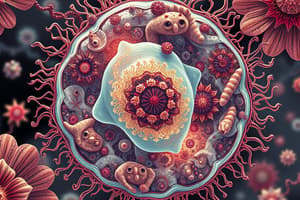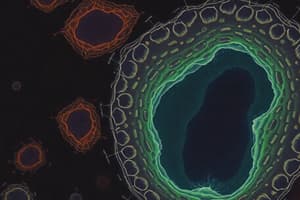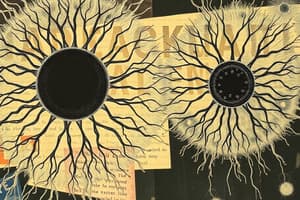Podcast
Questions and Answers
What is a unique feature of prokaryotic cells compared to eukaryotic cells?
What is a unique feature of prokaryotic cells compared to eukaryotic cells?
- They are usually larger than eukaryotic cells.
- They possess membrane-bound organelles.
- They lack a true nucleus. (correct)
- They have a defined nucleus.
Which organelle is primarily responsible for ATP production in eukaryotic cells?
Which organelle is primarily responsible for ATP production in eukaryotic cells?
- Mitochondria (correct)
- Golgi apparatus
- Endoplasmic reticulum
- Ribosome
What role does the smooth endoplasmic reticulum (ER) play in a cell?
What role does the smooth endoplasmic reticulum (ER) play in a cell?
- Energy production
- Protein synthesis
- Lipid synthesis and detoxification (correct)
- Transport of proteins to the Golgi apparatus
Which of the following processes results in the production of gametes?
Which of the following processes results in the production of gametes?
How do cells primarily communicate with each other?
How do cells primarily communicate with each other?
What is the main output of cellular respiration?
What is the main output of cellular respiration?
Which component of the cell membrane contributes to its selectively permeable nature?
Which component of the cell membrane contributes to its selectively permeable nature?
In which part of the cell does glycolysis occur?
In which part of the cell does glycolysis occur?
Flashcards are hidden until you start studying
Study Notes
Cell Biology
Basic Unit of Life
- Cells are the fundamental units of life.
- Two main types: Prokaryotic and Eukaryotic.
Prokaryotic Cells
- Lack a nucleus; DNA is in the nucleoid region.
- Usually smaller than eukaryotic cells.
- Examples: Bacteria and Archaea.
Eukaryotic Cells
- Have a defined nucleus containing DNA.
- Larger and more complex than prokaryotic cells.
- Organelles include mitochondria, endoplasmic reticulum, Golgi apparatus, etc.
Cell Membrane
- Composed of a phospholipid bilayer with embedded proteins.
- Functions:
- Selectively permeable barrier.
- Communication with other cells.
- Transport of substances in and out.
Organelles
- Nucleus: Contains genetic material; controls cell activities.
- Mitochondria: Powerhouse of the cell; site of ATP production.
- Ribosomes: Sites of protein synthesis.
- Endoplasmic Reticulum (ER):
- Rough ER: Studded with ribosomes; involved in protein synthesis.
- Smooth ER: Lacks ribosomes; involved in lipid synthesis and detoxification.
- Golgi Apparatus: Modifies, sorts, and packages proteins and lipids.
- Lysosomes: Contain enzymes for digestion of waste materials.
- Cytoskeleton: Provides structural support; involved in cell movement.
Cell Division
- Mitosis: Process of cell division resulting in two identical daughter cells.
- Meiosis: Process that produces gametes with half the number of chromosomes.
Cell Communication
- Cells communicate through signaling molecules and receptors.
- Types of signaling:
- Autocrine: Affects the same cell.
- Paracrine: Affects nearby cells.
- Endocrine: Involves hormones traveling through the bloodstream.
Cellular Respiration
- Process by which cells convert glucose and oxygen into energy (ATP).
- Stages:
- Glycolysis (in cytoplasm)
- Krebs Cycle (in mitochondria)
- Electron Transport Chain (in mitochondria)
Photosynthesis (in Plant Cells)
- Process by which plants convert sunlight into chemical energy.
- Occurs in chloroplasts.
- Key stages:
- Light-dependent reactions (convert light energy to chemical energy)
- Calvin cycle (uses chemical energy to synthesize glucose)
Cell Theory
- All living organisms are composed of cells.
- The cell is the basic unit of life.
- All cells arise from pre-existing cells.
Basic Unit of Life
- Cells are the fundamental building blocks of all living organisms.
- Two primary types of cells: Prokaryotic and Eukaryotic.
Prokaryotic Cells
- Characterized by the absence of a nucleus; DNA is located in the nucleoid region.
- Generally smaller in size compared to eukaryotic cells.
- Examples include Bacteria and Archaea.
Eukaryotic Cells
- Defined by the presence of a nucleus that houses DNA.
- Typically larger and more complex than prokaryotic cells.
- Contain various organelles such as mitochondria, endoplasmic reticulum, and Golgi apparatus.
Cell Membrane
- Structure consists of a phospholipid bilayer with proteins embedded within it.
- Functions as a selectively permeable barrier, allowing for selective movement of substances.
- Plays a vital role in intercellular communication.
Organelles
- Nucleus: Stores genetic material and regulates cell processes.
- Mitochondria: Known as the cell's powerhouse; responsible for ATP production.
- Ribosomes: Essential for protein synthesis, found both free in cytoplasm and on the rough ER.
- Endoplasmic Reticulum (ER):
- Rough ER: Ribosome-studded; primarily functions in protein synthesis.
- Smooth ER: Lacks ribosomes; involved in lipid synthesis and detoxification of harmful substances.
- Golgi Apparatus: Modifies, sorts, and packages proteins and lipids for secretion or delivery within the cell.
- Lysosomes: Contain digestive enzymes used for breaking down waste materials.
- Cytoskeleton: Provides structural support and is involved in cell motility and shape maintenance.
Cell Division
- Mitosis: A type of cell division resulting in two identical daughter cells, crucial for growth and repair.
- Meiosis: Special form of cell division that produces gametes, containing half the number of chromosomes compared to the parent cell.
Cell Communication
- Cells communicate using signaling molecules and specific receptors capable of receiving signals.
- Types of signaling mechanisms:
- Autocrine: Affects the signaling cell itself.
- Paracrine: Influences nearby cells in the local environment.
- Endocrine: Involves hormones that travel through the bloodstream to distant target cells.
Cellular Respiration
- The process that converts glucose and oxygen into usable energy (ATP) for cellular activities.
- Stages include:
- Glycolysis: Occurs in the cytoplasm, breaking down glucose.
- Krebs Cycle: Takes place in mitochondria; produces electron carriers.
- Electron Transport Chain: Also occurs in mitochondria; generates ATP through oxidative phosphorylation.
Photosynthesis (in Plant Cells)
- Conversion of sunlight into chemical energy by plants, primarily occurring in chloroplasts.
- Key stages:
- Light-dependent reactions: Transform light energy into chemical energy, producing ATP and NADPH.
- Calvin cycle: Utilizes ATP and NADPH to synthesize glucose from CO₂.
Cell Theory
- Asserts that all living organisms are made up of cells.
- Emphasizes that the cell is the basic unit of life.
- States that all cells arise from previously existing cells, instrumental in understanding reproduction and growth.
Studying That Suits You
Use AI to generate personalized quizzes and flashcards to suit your learning preferences.




